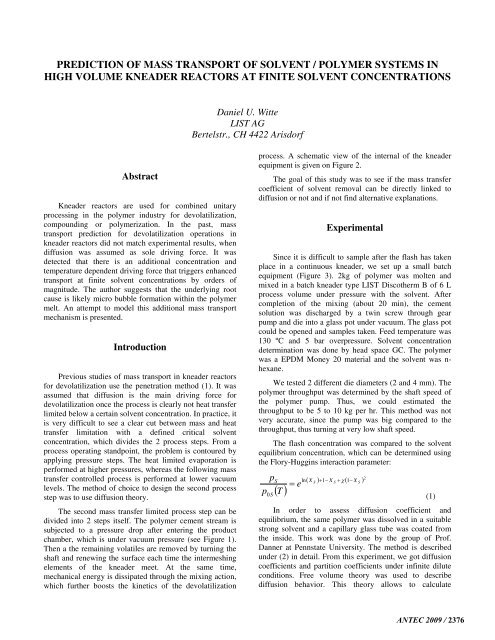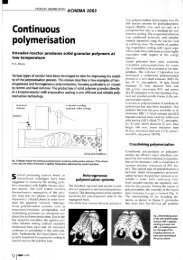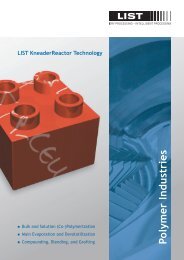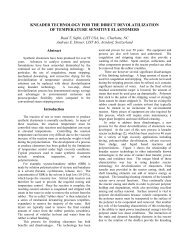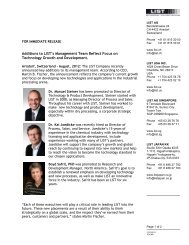eqS - LIST Dry Processing
eqS - LIST Dry Processing
eqS - LIST Dry Processing
You also want an ePaper? Increase the reach of your titles
YUMPU automatically turns print PDFs into web optimized ePapers that Google loves.
PREDICTION OF MASS TRANSPORT OF SOLVENT / POLYMER SYSTEMS IN<br />
HIGH VOLUME KNEADER REACTORS AT FINITE SOLVENT CONCENTRATIONS<br />
Abstract<br />
Kneader reactors are used for combined unitary<br />
processing in the polymer industry for devolatilization,<br />
compounding or polymerization. In the past, mass<br />
transport prediction for devolatilization operations in<br />
kneader reactors did not match experimental results, when<br />
diffusion was assumed as sole driving force. It was<br />
detected that there is an additional concentration and<br />
temperature dependent driving force that triggers enhanced<br />
transport at finite solvent concentrations by orders of<br />
magnitude. The author suggests that the underlying root<br />
cause is likely micro bubble formation within the polymer<br />
melt. An attempt to model this additional mass transport<br />
mechanism is presented.<br />
Introduction<br />
Previous studies of mass transport in kneader reactors<br />
for devolatilization use the penetration method (1). It was<br />
assumed that diffusion is the main driving force for<br />
devolatilization once the process is clearly not heat transfer<br />
limited below a certain solvent concentration. In practice, it<br />
is very difficult to see a clear cut between mass and heat<br />
transfer limitation with a defined critical solvent<br />
concentration, which divides the 2 process steps. From a<br />
process operating standpoint, the problem is contoured by<br />
applying pressure steps. The heat limited evaporation is<br />
performed at higher pressures, whereas the following mass<br />
transfer controlled process is performed at lower vacuum<br />
levels. The method of choice to design the second process<br />
step was to use diffusion theory.<br />
The second mass transfer limited process step can be<br />
divided into 2 steps itself. The polymer cement stream is<br />
subjected to a pressure drop after entering the product<br />
chamber, which is under vacuum pressure (see Figure 1).<br />
Then a the remaining volatiles are removed by turning the<br />
shaft and renewing the surface each time the intermeshing<br />
elements of the kneader meet. At the same time,<br />
mechanical energy is dissipated through the mixing action,<br />
which further boosts the kinetics of the devolatilization<br />
Daniel U. Witte<br />
<strong>LIST</strong> AG<br />
Bertelstr., CH 4422 Arisdorf<br />
process. A schematic view of the internal of the kneader<br />
equipment is given on Figure 2.<br />
The goal of this study was to see if the mass transfer<br />
coefficient of solvent removal can be directly linked to<br />
diffusion or not and if not find alternative explanations.<br />
Experimental<br />
Since it is difficult to sample after the flash has taken<br />
place in a continuous kneader, we set up a small batch<br />
equipment (Figure 3). 2kg of polymer was molten and<br />
mixed in a batch kneader type <strong>LIST</strong> Discotherm B of 6 L<br />
process volume under pressure with the solvent. After<br />
completion of the mixing (about 20 min), the cement<br />
solution was discharged by a twin screw through gear<br />
pump and die into a glass pot under vacuum. The glass pot<br />
could be opened and samples taken. Feed temperature was<br />
130 ºC and 5 bar overpressure. Solvent concentration<br />
determination was done by head space GC. The polymer<br />
was a EPDM Money 20 material and the solvent was nhexane.<br />
We tested 2 different die diameters (2 and 4 mm). The<br />
polymer throughput was determined by the shaft speed of<br />
the polymer pump. Thus, we could estimated the<br />
throughput to be 5 to 10 kg per hr. This method was not<br />
very accurate, since the pump was big compared to the<br />
throughput, thus turning at very low shaft speed.<br />
The flash concentration was compared to the solvent<br />
equilibrium concentration, which can be determined using<br />
the Flory-Huggins interaction parameter:<br />
pS ln S S −<br />
= e<br />
p<br />
0S<br />
( T )<br />
( ) ( ) 2<br />
X + 1−<br />
X + χ 1 X<br />
In order to assess diffusion coefficient and<br />
equilibrium, the same polymer was dissolved in a suitable<br />
strong solvent and a capillary glass tube was coated from<br />
the inside. This work was done by the group of Prof.<br />
Danner at Pennstate University. The method is described<br />
under (2) in detail. From this experiment, we got diffusion<br />
coefficients and partition coefficients under infinite dilute<br />
conditions. Free volume theory was used to describe<br />
diffusion behavior. This theory allows to calculate<br />
S<br />
(1)<br />
ANTEC 2009 / 2376
diffusion coefficient as function of temperature and solvent<br />
concentration. The predicted change in value of the<br />
diffusion coefficient was found to be close to constant at<br />
working conditions we have chosen and can be neglected.<br />
From the partition coefficient, we can derive the Flory-<br />
Huggins interaction parameter, which is assumed not to be<br />
dependent on solvent concentration (all values taken at<br />
temperature T):<br />
⎛ RT<br />
= ln ⎜<br />
⎝ p0S<br />
M<br />
ρS<br />
S<br />
⎞<br />
⎟ −1<br />
K ⎠<br />
χ (2)<br />
The effective mass transfer of the kneader equipment<br />
was measured within a <strong>LIST</strong> Discotherm B 160 L<br />
equipment (see Figure 4). We chose such a large<br />
equipment since the devolatilization decreases with the<br />
size of the equipment. Thus we got a more alike situation<br />
as compared to industrial scale devolatilization equipment.<br />
Another reason was that for smaller equipment the product<br />
sampling rate would be that high that errors cannot be<br />
excluded. We heated the polymer and the solvent up at<br />
same conditions as for the flash tests (50kg of polymer)<br />
and pulled vacuum wile turning the kneader agitator at 30<br />
RPM. For sampling, the kneader was stopped and vacuum<br />
broken. Solvent concentration determination was done by<br />
head space GC.<br />
The mass transfer rate in the kneader can be described<br />
using the penetration theory:<br />
dm<br />
dt<br />
D<br />
( w )<br />
S S , eff<br />
= − 2 AI<br />
ρcement<br />
S , bulk − wS<br />
. eq<br />
π tcontact<br />
The effective diffusion coefficient can be divided up<br />
into 2 components among one is the diffusion itself and<br />
additional term, which is solvent concentration dependent:<br />
D S , eff DS<br />
, fv + DS<br />
, conv<br />
(3)<br />
= (4)<br />
At infinite dilution only diffusion takes place, whereas<br />
at higher solvent concentrations a convective part has to be<br />
added. Since the kneader equipment cannot be operated at<br />
infinite conditions and produce meaningful measurable<br />
results, data at higher concentrations has to be extrapolated<br />
to infinite conditions. This allows to confirm AI, which, so<br />
far, had to be estimated optically.<br />
Results and discussion<br />
The results of the flash tests showed, that the flash<br />
concentration can be anywhere between 0.1 and 2 %<br />
solvent. There is a trend that smaller die diameters lead to a<br />
lower solvent flash concentration. The correlation to<br />
solvent equilibrium concentration is generally weak. In any<br />
case the data scattered a lot. We believe, that the data<br />
spreads that much, because there is a mass transport<br />
2377 / ANTEC 2009<br />
limitation occurring during the flash step. This means, that<br />
we would need more than data from thermodynamics. The<br />
scale-up of this process step is therefore necessarily highly<br />
empirical. Fortunately for us, we found out later that the<br />
flash calculation can be neglected and feed concentrations<br />
assumed using the new approach of DS,conv as we will see<br />
further down in this paper.<br />
Figure 5 shows the test results of calculated<br />
convective mass transport according to Eq. 4. As can be<br />
seen, There seems to be a linear relationship between<br />
solvent concentration and convective mass transport. The<br />
y-intercept is close to 0 m 2 /s, which confirms the<br />
penetration model an AI chosen. The data is obviously to<br />
small in number to accurately determine AI. However, the<br />
chosen approach seems to be confirmed and the<br />
extrapolation from finite to infinite solvent concentration<br />
easy. Using the given data plot, a simple empirical<br />
description of convective mass transport would be:<br />
⎡ s ⎤<br />
D S , conv ⎢ = CD,<br />
S , convw<br />
2<br />
,<br />
m ⎥<br />
⎣ ⎦<br />
S bulk<br />
The constant is strongly dependent on temperature.<br />
We suggest a mixed linear and exponential approach,<br />
which seems best describe the data:<br />
C<br />
D,<br />
S , conv<br />
CD<br />
, S , conv,<br />
1 T + CD<br />
, S , conv,<br />
2<br />
(5)<br />
= e<br />
(6)<br />
This approach allows to compare similar<br />
polymer/solvent systems, but cannot be used for solvent<br />
system of much different vapor pressure curve than the<br />
tested hexane. A more detailed DOE will allow to further<br />
characterize the physical /chemical nature of the<br />
convective term. In the meantime, we have achieved to<br />
establish a valid approach for scale-up of similar polymer /<br />
solvent systems. The author believes, that micro-bubble<br />
formation and their convective transport through the shaft<br />
rotation is responsible for convective term. This suggests<br />
that the penetration theory can be applied, as was<br />
demonstrated here. There are a number of publications<br />
available, which suggest such a mechanism (3).<br />
The method described here suggests that at finite<br />
solvent concentration, the mass transport is much higher<br />
than previously calculated. This also means, that the<br />
contribution of the flash devolatilization at the feed into the<br />
kneader decreases in importance. We found, that for<br />
industrial devolatilization equipment, this contribution can<br />
easily be neglected if target volatile contents are low<br />
enough. This target volatile content will depend on the<br />
volatility of the solvent. This suggests that there will be<br />
always a rotary equipment required to do final volatile<br />
removal, unless “smelling” polymer can be accepted.<br />
Summary
Devolatilization tests were performed trying to link the<br />
well established penetration theory for devolatilization in<br />
rotating equipment to diffusion theory especially for the<br />
case of kneader type equipment. We were able to<br />
demonstrate that diffusion is a special case at low volatile<br />
content whereas at higher volatile content, convective mass<br />
transport mechanisms.<br />
The new model will allow to better design<br />
devolatilization process on industrial scale. Furthermore,<br />
evaporation processes can now be described with this<br />
model as well, since at higher solvent concentrations the<br />
mass transfer will naturally tend to equilibrium condition<br />
in the mixture, which is the boiling point of the mixture.<br />
Nomenclature<br />
A mass exchange surface [m 2 ]<br />
C constant [-]<br />
D diffusion coefficient [m 2 /s]<br />
K partition coefficient [-]<br />
m mass [kg]<br />
M molar mass [kg/mol]<br />
p operating pressure [Pa]<br />
p0 vapor pressure [Pa]<br />
R ideal gas constant [J/mol/K]<br />
t time, duration [s]<br />
T temperature [K]<br />
w mass part [kg/kg]<br />
X volumetric part [m 3 /m 3 ]<br />
greek:<br />
χ Flory-Huggins interaction parameter [-]<br />
ρ density [kg/m 3 ]<br />
indices:<br />
bulk within bulk of material<br />
contact contact<br />
conv convective<br />
eff effective<br />
eq at equilibrium<br />
fv free volume (diffusion controlled)<br />
S solvent<br />
References<br />
1. Daniel Witte, Computer Scale-up Model for<br />
Desolventizing Highly Viscous Polymers in Kneader<br />
Equipment, Antec (2005)<br />
2. Albalak, R.J., Polymer Devolatilization, 10th edition,<br />
Marcel Dekker Inc., ISBN: 0-8247-9627-6, 35 pp<br />
3. Albalak, R.J., Polymer Devolatilization, 10th edition,<br />
Marcel Dekker Inc., ISBN: 0-8247-9627-6, 67 pp<br />
Key Words<br />
Devolatilization, evaporation, kneader, finishing,<br />
diffusion, mass transfer<br />
ANTEC 2009 / 2378
Feed<br />
Evaporation<br />
Off gas<br />
Finishing<br />
Figure 1: Kneader finishing process for final volatile removal under vacuum<br />
Figure 2: Single shaft kneader<br />
2379 / ANTEC 2009<br />
Off gas<br />
Product
CME 6<br />
Comm.no. 9187<br />
Md specific = 11.13 Nm / bar<br />
"Gachot" - valve<br />
PIR<br />
LAUDA - Heater<br />
- Gear pump<br />
- Gachot<br />
- Endplate<br />
N2<br />
Figure 3: Test set up for flash trials<br />
TC<br />
TIR<br />
Glass pot<br />
6 l<br />
0 - 6 bar<br />
ADS 25<br />
CM E 6<br />
6.3 l / 0.247 m 2<br />
TI<br />
PIR<br />
N2<br />
GP 45 / 45<br />
TIR<br />
HTT<br />
electrical heating mat<br />
sight window<br />
cooling water<br />
PDR<br />
2 l<br />
p = atm.<br />
screw vacuum<br />
pump<br />
ANTEC 2009 / 2380
Glass condenser<br />
cooling water<br />
Sampling through<br />
Figure 4: Test set up for mass transfer in kneader<br />
2381 / ANTEC 2009<br />
sightglass<br />
sightglass<br />
DTB 160 Batch<br />
A = 3.3 m 2<br />
V = 175 l<br />
TIR<br />
PIR<br />
roots pump (1000m 3 /h)<br />
to cold trap<br />
N2<br />
sightglass<br />
HYDRAULIC MOTOR : TYPE HMS 410<br />
Md spec. (shaft) : 62.4 Nm/bar<br />
PC<br />
rotary vane pump (100 m 3 /h)<br />
2 : 1<br />
TIR<br />
TIR<br />
PDR<br />
HTM<br />
HTM
DS,conv [m 2 /s]<br />
6.000E-09<br />
5.000E-09<br />
4.000E-09<br />
3.000E-09<br />
2.000E-09<br />
1.000E-09<br />
140 ºC<br />
200 ºC<br />
170 ºC<br />
Linear (140 ºC)<br />
Linear (200 ºC)<br />
Linear (170 ºC)<br />
0.000E+00<br />
0.000E+00 5.000E-04 1.000E-03 1.500E-03 2.000E-03<br />
solvent mass part [-]<br />
Figure 5: Test results for convective mass transport in kneader equipment<br />
ANTEC 2009 / 2382


